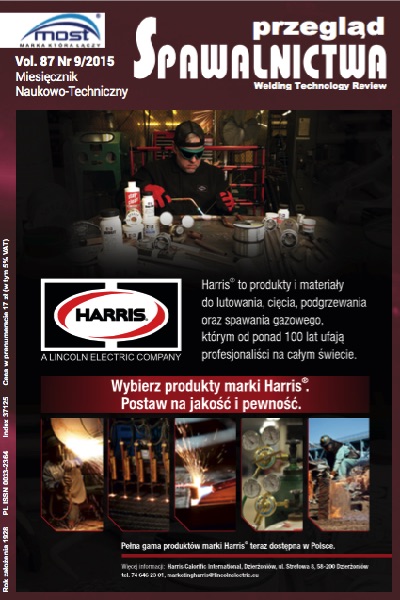Ocena jakości warstw wierzchnich kompozytowych napawanych GMA w sposób zrobotyzowany na powierzchniach krzywek przesiewacza koksu ze stali HTK 900H
Main Article Content
Abstract
Przedmiotem badań była analiza wpływu parametrów procesu zrobotyzowanego napawania GMA drutem rdzeniowym EnDOtec DO48 o średnicy 1,6 mm powierzchni roboczych krzywek przesiewacza koksu ze stali trudnościeralnej HTK 900H na jakość, kształt i odporność na zużycie ścierne napoin. Próby napawania prowadzono z zastosowaniem robota spawalniczego Reis SRV6 oraz synergicznego urządzenia spawalniczego TotalArc 5000. Napoiny próbne wykonane drutem rdzeniowym EnDOtec DO48 wykazują cechy materiału kompozytowego z węglikami wolframu osadzonymi w osnowie metalicznej. Rozmieszczenie węglików na przekroju poprzecznym napoiny jest niejednorodne, gdyż gromadzą się one głównie w pobliżu linii wtopienia napoin. Twardość metalu osnowy przekracza 52 HRC, przy twardości podłoża ze stali HTK 900H w zakresie 33 do 35 HRC. Pomimo pęknięć poprzecznych, napoiny wykazują o rząd wielkości wyższą odporność na zużycie ścierne typu metal-metal w próbie ball-on-plate.
Evaluation of the quality of composite surface layers produced by robotic GMA cladding on cams of coke screening plant made of HTK 900H steel
Abstract
The subject of the study was to analyse the influence of process parameters of robotic GMA cladding, by cored wire EnDOtec DO48 having a diameter of 1,6 mm, of cams working surfaces of coke screening plant made of HTK 900H wear resistant steel on the quality, shape and abrasive wear resistance of test surface layers. The test of cladding were performed by means of a weld- ing robot Reis SRV6 and a synergic welding machine TotalArc 5000. The test surface layers produced by the cored wire EnDOtec DO 48 exhibit characteristics of composite material with tungsten carbides embedded in the metal matrix. Distribution of carbides on the cross- section of surface layers is inhomogeneous, because the carbides accumulate near the fusion line. Hardness of the metallic matrix exceeds 52 HRC and the hardness of the substrate of HTK 900H steel is in the range of 33 to 35 HRC. Although transverse cracks, the surface lay- ers exhibit an order of magnitude higher resistance to the metal-metal wear type during the ball-on-plate tests.
Downloads
Article Details
Creative Commons CC BY 4.0 https://creativecommons.org/licenses/by/4.0/
Welding Technology Review (WTR) articles are published open access under a CC BY licence (Creative Commons Attribution 4.0 International licence). The CC BY licence is the most open licence available and considered the industry 'gold standard' for open access; it is also preferred by many funders. This licence allows readers to copy and redistribute the material in any medium or format, and to alter, transform, or build upon the material, including for commercial use, providing the original author is credited.
References
A. Lisiecki, A. Majowski, T. Gorzelik, J. Jarek, P. Gorzela, A. Kurc-Lisiecka: Sterowanie jakością i trwałością części roboczych brykieciarki napawanych metodą MMA w procesie wytwarzania brykietów stalowych. Biuletyn Instytutu Spawalnictwa, Nr 4, s. 8-15, 2015.
